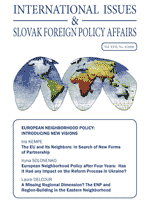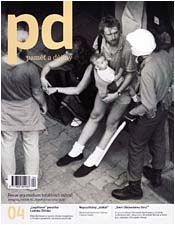Rába György: A körülmények hatalma • 913 Tiltakozik • 913 Horváth Elemér: magyar árok • 914 körkép a 2. millennium után • 914 fegyverletétel • 915 Dunajcsik Mátyás: Szekvenciák szonettzongorára • 915 Imitatio Petri • 916 Macskatangó • 917 Csengery Kristóf: A hangok túloldala • 918 Atyjának szellemét szólítja • 919
More...Forgács Éva: Csernus Tibor • 950 Perneczky Géza: Héj és lepel (Pauer Gyula retrospektív kiállítása) • 955 Keresztesi József: Műbírálat és diagnózis (Angyalosi Gergely: Romtalanítás) • 973 Farkas János László: Az idõ berendezése (Veres András: Távolodó hagyományok) • 976 Doboss Gyula: Hungarian Psycho (Garaczi László: Gyarmati nõ) • 983 Nemes Z. Márió: Bret Easton Ellis: Holdpark • 987
More...
Keywords: financial instruments,ENPI
As our experience shows, EU policies towards neighbors are in many ways ineffective. One of the reasons could be inadequate and badly organized and positioned financial tools that are helping policies to be realized. Introduction of the new instrument (ENPI) brought new hopes that the European neighborhood policy will better on target and will meet needs, hopes and development strategies of not only EU member states, but also EU neighborhood countries. Even though it’s difficult to evaluate the ENPI impacts today (at the stage when the new programs just started to work), it’s clear that we already need discussion on the ENPI reform. It’s because the ENPI needs more visibility, transparency and accountability, it needs more involvement of other actors (NGOs, local governments …) in to the processes related to spending of the EU funds in neighboring countries and it also needs citizens’ support so aims of the ENP could became reality. We also need more simple, less bureaucratic, varied and flexible financial (delivery) tools that will cope with the emerging problems that ENP countries face.
More...
Keywords: ENP; ENP instruments; reform process
This paper argues that although the ENP has failed to give a boost to the reform process by and large, it has developed instruments that have managed to support pro-reform trends and pro-reform constituencies in Ukraine, as well as to establish good practices and reform-minded institutions. Those are not well entrenched right away in order to have impact on the reform process, but they entail the potential to Europeanize Ukraine in the long run. In a way, the ENP has contributed to the development of the ‘enclaves of Europeanization’ in Ukraine. Nevertheless, the paper argues, the ENP in its current shape is not sufficient if the EU is serious about the success of reforms in its neighborhood. The weak domestic potential for reforms might not be sustained without strong support from the outside. To tackle this, the EU needs to strengthen its policy in several substantial ways.
More...
Keywords: regional dimension; ENP
Through examining the EU’s record in region-building in its Eastern neighborhood, this paper intends to identify the reasons that have prevented the EU from supporting regional cooperation in the ENP, especially in its Eastern component as well as to question the emergence of an EU regional vision in the Eastern part of the continent and the relevance of ‘thinking about’ the Eastern neighborhood on a regional basis.
More...

Keywords: ENP; Enlargement; reform; Russia
Learning from its experience with the eastern enlargement, the European Union developed a neighborhood policy aware of the need to avoid the creation of a new dividing line in Europe that might put a strain on the relations between the new member states and other countries of the Central and Eastern Europe that would border the new EU. In the light of changes that occurred over time, especially Russia’s resurgence as not only a regional, but a global power, the author points out the obvious shortcomings of the EU’s policy and why it failed to meet the expectations of both the countries encompassed by the policy, and the EU. In addition, the author gives an overview of the changes to the neighborhood policy proposed by the EU member states and, finally, points out the importance of devising a coherent strategy towards the region that would yield long-term results.
More...
Keywords: Action Plan; Ukraine; New Tools
The ENP was constituted in 2004 with the aim of adapting the enlarged EU to its enlarged neighborhood, and to support the transformation process in neighboring countries in line with EU standards. The main universal instrument of the ENP came to be the Action Plan. This article looks for further development of the Action Plan as an ENP instrument in terms of its both content and institutional framework following the experience of Ukraine. In addition, the article tries to identify the interplay of the Action Plan with the new sectoral tools of the ENP in order to eliminate the flaws of its existing implements.
More...

Valdice Prison is one of the harshest correctional facilities, which was usually only used for criminals convicted of particularly serious and violent crimes before 1948. Naturally, during the era of communist totalitarianism, this prison was frequently the “home” of political prisoners unfairly convicted by the communist judiciary. People such as the writer Jiří Stránský, the priest and theologian Otto Mádr, the priest Felix Davídek, professor Josef Zvěřina and the poet Ivan Jirous etc. spent many years of compulsory imprisonment behind the walls of Valdice. Moreover, this jail converted from a Carthusian monastery had very bad living conditions and unsatisfactory work assignments. It was also known for the harsh isolation of its so-called “third department.” Since 1989, the prison has once again only been used for real criminals.
More...

For most of us, the demonstrations of 1989 are linked with the November Velvet Revolution and the fall of communism. In fact, this was actually the culmination of a longstanding process, which is inextricably linked with developments in the other countries of the Soviet Bloc. The events that led to the collapse of the Communist Party’s totalitarian regime in Czechoslovakia in November 1989 were preceded by growing tensions in society, an increase in opposition activities and a wave of anti-government demonstrations. Although demonstrations in August 1989 were suppressed using the Standby Regiment of the State Police, they had more work than they expected. They had to check the identities of 1560 people and made almost 500 arrests. The opposition movement had clearly been gathering strength.
More...

The Freedom Legion was a resistance group that was created out of many groups in the autumn of 1952 and the spring of 1953 with the aim of establishing a control centre for domestic anti-communist resistance. It was headed by three people: Bohumil Kokrda, Miloslav Novák and Stanislav Cába. Surprisingly, the activity of this illegal group stirred up the American presidential campaign in the second half of 1952 and subsequently gave rise to broadcasts by Radio Free Europe and the Voice of America, which reacted to it. The Republicans ran a campaign with a slogan declaring their intention not to pursue the containment of communism, but the liberation of the nations of Central and Eastern Europe. They criticised the Democrats and Harry Truman for losing the important region of Eastern Europe and leaving it to its fate. The hopeful domestic resistance to communism began to actively operate against the regime. They organised hundreds of followers and prepared for a possible confrontation between the super powers. The Freedom Legion – DAAK resistance group was a very diverse resistance organisation that set itself the difficult goals of concentrating and unifying all anti-communist forces, primarily at home but also abroad. This did not happen, however. Instead, it marked the beginning of mass arrests of dozens of people, political trials and convictions that sent people to prison for decades.
More...